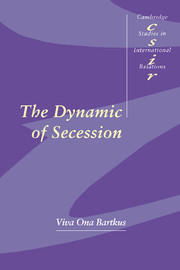2 - Theoretical foundation for analysis of secession
Published online by Cambridge University Press: 22 September 2009
Summary
This chapter begins by discussing the process of disintegration, then introduces the four necessary elements for secession: a distinct community,territory, leaders, and discontent. Furthermore, while specifying these four elements, the chapter also discusses the use of “distinct community” in place of other terms such as “nation” or “ethnic group.” The chapter then moves on to the debate concerning the “right” to secede in order to provide a solid foundation for the subsequent discussion of the analytical framework investigating the secession decision. The analytical framework is grounded in a set of costs and benefits, as perceived by the distinct community, of the political alternatives of continued membership in the existing state and secession. The cost/benefit approach elucidates many of the considerations and factors in a secession decision, but cannot and does not address the moral questions inherent in the secession dynamic. Critical to any specific secession is its own internal justification; of central importance to any study of secession crises are the moral issues concerning their justification. The analytical framework therefore rests on this normative bedrock underpinning secession. The book argues, however, that moral justifications, although integral to the understanding of a secession attempt, are not sufficient in and of themselves to explain the timing of the decision to secede. For a community to decide to secede, it must perceive a change in its circumstances and its political alternatives.
Disintegration and the “secession crisis”
Secession is a logical, although not inevitable, conclusion of the process of political disintegration.
- Type
- Chapter
- Information
- The Dynamic of Secession , pp. 8 - 30Publisher: Cambridge University PressPrint publication year: 1999

